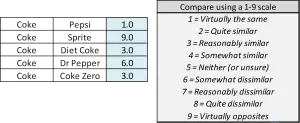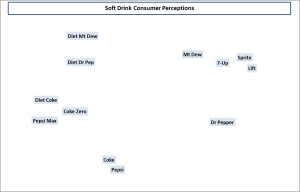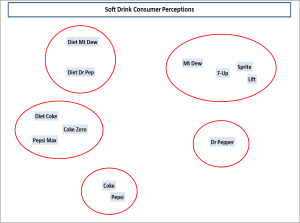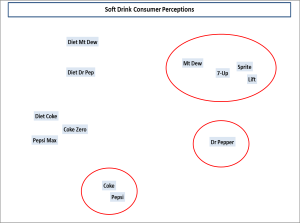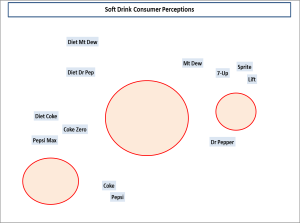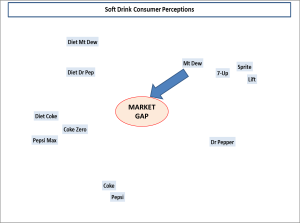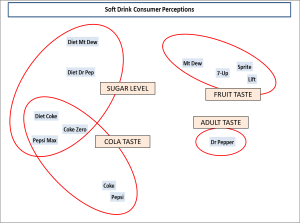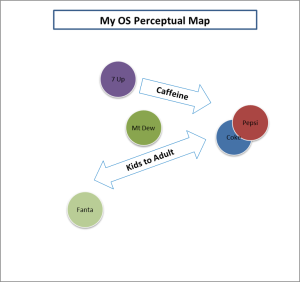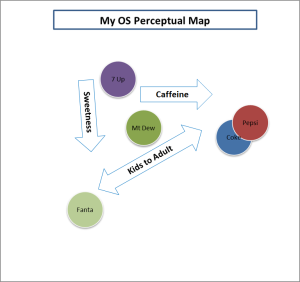Get the Free OS Mapping Excel Template: os-overall-similarity-perceptual-map-template
Contents
- 1 Step One – Understand How the Data is Constructed
- 2 Step Two – Produce the OS Perceptual Maps
- 3 Step Three – Identify the Competitive Sets
- 4 Step Four – Identify the Extent of Differentiation
- 5 Step Five – Identify Gaps in the Market
- 6 Step Six – Check for Repositioning Shifts or Opportunities
- 7 Step Seven – Interpret the Underlying Attributes
- 8 Key points to know about interpreting an overall similarities perceptual map
- 9 HELPFUL VIDEOS
- 10 Perceptual Maps 4 Marketing
Step One – Understand How the Data is Constructed
The first step in interpreting an overall similarities (OS) perceptual map is to understand how the data is constructed. Instead of asking consumers to rate brands on an individual product attribute basis, consumers compare PAIRS of brands and rate how similar or different they are in their minds (that is, their perception).
As you can see on the left, the brands (e.g. Coke and Pepsi) are paired together and consumers will need to compare them using the comparison scale (in this case a 1 to 9 scale is being used).
For Coke versus Pepsi, the respondent scored the comparison between these tow brands as a 1.0 – meaning that the respondent perceives these two brands as “virtually” the same.
This brand pairing process then continues in sets – next it is Coke versus Sprite, then Coke versus Diet Coke as so on.
It is always important to remember that we are measuring the consumer’s perceptions rather than a technical reality between the brands.
Step Two – Produce the OS Perceptual Maps
The next step used to physically produce the overall similarity perceptual map. Fortunately this website provides a free download of an Excel template that will allow you to do this relatively easily.
Depending upon your market, competing brands, and source of data, your map may look a little bit different to the one on the left, the conceptually it should be quite similar.
What you should have is the brands scattered around the map with some underlying logic, which should be based upon your knowledge of that market.
Step Three – Identify the Competitive Sets
As you can see on the left, this perceptual map has five sets of competitors identified. This is on the basis of the natural clustering of the brands that have occurred on the map.
Therefore, this is an ideal approach to identify how consumers see direct and indirect competitors in the marketplace.
In a busy perceptual map, where there are lots of brands listed, this might not be as obvious.
Also different target markets may have a slightly different view of the competitive sets. Fortunately it is possible to run this map on a market segment basis (if the data is available).
Step Four – Identify the Extent of Differentiation
You should note, by viewing the three competitive sets highlighted on the left, that there are different numbers of competitors in each group.
In this example, Dr Pepper is in a competitive set by itself. This means that on this view of the market it has a highly differentiated market position.
Compare this to the four brands in the top circle, where they have far less unique differentiation and are perceived relatively similar to each other by the consumers in the market.
Step Five – Identify Gaps in the Market
One of the key uses of the perceptual map is to identify gaps, or opportunities, in the marketplace.
In this particular example, there are three possible gaps that have been identified, where no brand is perceived to be positioned.
As an example, the Pepsi Next product which was released in 2012 would probably sit in the circle between Coke and Pepsi Max.
Step Six – Check for Repositioning Shifts or Opportunities
If this type of perceptual map is produced on a regular basis, say yearly, it would be possible to identify how the brands have shifted, or have been repositioned, over that time.
Likewise in relation to Step Five above, it may be possible to determine how an existing brand can be repositioned for its competitive advantage
Step Seven – Interpret the Underlying Attributes
The final step, which is probably the most challenging, is to work out HOW the consumers differentiate between the brands in the market.
To help us – let’s look a a simpler map. Here another possible set of consumer-based perception factors are shown in the next map. You should note that two potential attributes have been identified.
And it is even possible to build in more than two factors – as shown in this OS perceptual map, where three underlying factors have been indicated – resulting in three axes or dimensions that consumers use to choose between competing brands.
Key points to know about interpreting an overall similarities perceptual map
- You need to determine the likely factors/influences that consumers have used in forming their view (perception) of how the different brands in the market are interrelated
- These influences can run in any direction – that do NOT need to run up/down and left/right as found in a standard perceptual map – and the two factors do not need to run at right angles from each other
- There WILL be more than one logical solution – you may need to consider the best version for your needs
- You can have more than two factors on the same map
- Because it aggregates all perceptions into one map – it needs to force some of the relationships – therefore, no every single brand position may make 100% sense (think of it like an average) – try to map out some brands on paper on a similar/dissimilar basis and you will see that challenge once you get to 5+ brands
- It is a helpful technique because it forces you to think about the consumers and their thinking process
- BUT… a poor interpretation of the map (that is, identifying the wrong factors) will result in a poor understanding of the market and subsequent poor marketing decisions as a result
HELPFUL VIDEOS
How to Use the Overall Similarities (OS) Perceptual Map Free Template
How to Interpret an Overall Similarities (OS) Perceptual Map
An Introduction to Overall Similarities (OS) Perceptual Maps
Related Articles
- When to Use an Overall Similarities (OS) Perceptual Map
- Overall Similarities (OS) Perceptual Maps
- Different Types of Perceptual Maps
Perceptual Maps 4 Marketing
- The Home of the Free Perceptual Map Excel Template
- Downloaded over 100,000 times since 2013
- Always free, always will be
- Ideal tool for marketing students, analysts, and practitioners
Take me to the download page: Free Download of the Perceptual Map Template

